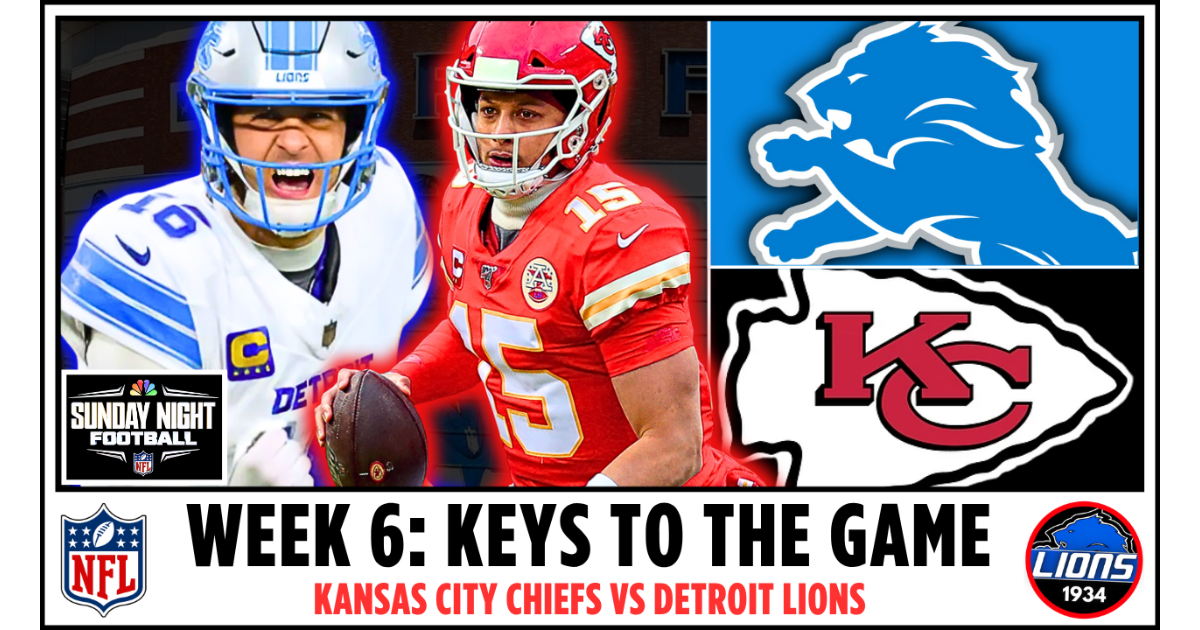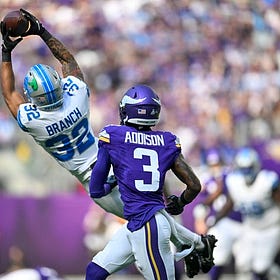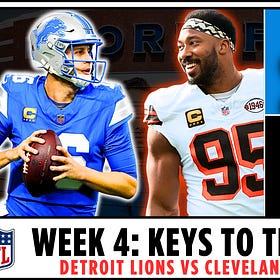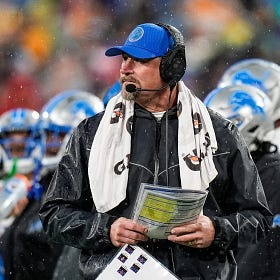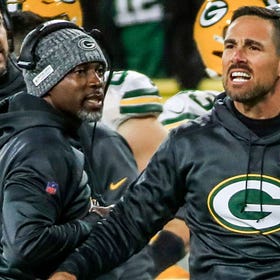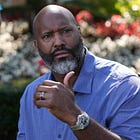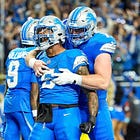NFL Week 6: Detroit Lions Keys To The Game Vs. Kansas City Chiefs
This isn’t about splash plays — it’s about forcing long drives, limiting explosives, and making Mahomes play patient football
The Week 6 Sunday Night Football matchup between the Detroit Lions (4–1) and the Kansas City Chiefs (2–3) brings together two franchises with championship ambitions and very different challenges. The matchup carries Week 6’s highest over/under at 51.5 points, which means Vegas expects a high‑scoring, fantasy‑friendly game. Same call I made on the Arrowhead Chief Podcast last week Tuesday.
Detroit arrives with the leagues #1 scoring offense, but faces a defensive identity test after a wave of injuries decimated the secondary. With both starting cornerbacks sidelined, safeties Brian Branch and Kerby Joseph listed as game‑time decisions. It didn’t help that the Lions added three more players to the “OUT” list Saturday, 3-way backup DB Avonte Maddox was added to the list.
First year defensive coordinator, Kelvin Sheppard, must lean on a healthy front seven to contain Patrick Mahomes and an explosive Kansas City aerial attack.
The storyline is clear: will the Lions’ physicality and discipline in the trenches offset the Chiefs’ speed, creativity, and off‑script brilliance of Andy Reid under the bright lights at Arrowhead Stadium? We find out Sunday night!
Detroit Lions: Keys to Victory
Dominate the Ground Game Early and Often
Actionable Key: Lean hard on the Jahmyr Gibbs–David Montgomery duo, exploiting the Chiefs’ issues with run defense and setting the tone from the opening possession.
The numbers paint a clear directive: Kansas City ranks just 21st in rush defense (123.4 yards allowed per game, 4.8 YPC, 29th in rush EPA), precisely the sort of statistical profile that Detroit’s zone-and-duo rushing attack is designed to break open. The Lions come in as the NFL’s seventh-ranked rushing offense (134.8 yards/game), with both Gibbs and Montgomery averaging over 60 rushing yards and punching in eight rushing TDs between them.
Establishing the ground game isn’t mere clock management—it’s about dictating the Chiefs’ defensive fronts, setting up manageable downs for Jared Goff, and limiting the time Patrick Mahomes spends on the field. Play-action becomes accessible, protections can be disguised, and, critically, the Detroit offensive line can be insulated from all-out pass rush scenarios. Against a KC defense that isn’t built to plug power running lanes, this path is Detroit’s surest avenue to sustained drives.
Protect Jared Goff with Scheme—Not Just Personnel
Actionable Key: Use heavy sets (two-tight end looks with Sam LaPorta and Brock Wright), chip blocks, and quick-game concepts to help Dan Skipper and reduce the Chiefs’ pass rush.
With stalwart LT Taylor Decker ruled out and backup options like Dan Skipper and Christian Mahogany pushed into key roles, Detroit’s O-line faces a stress test versus Chris Jones (1 sack, but constant pressure) and George Karlaftis (3.5 sacks, 6 TFL). The solution: don’t leave the replacements on an island. Tight ends can help the tackles set the edge in both pass protection and outside-zone runs, and pulling guards can offer varied protection angles.
Jared Goff (12 TD, 2 INT, NFL-best 75.2% completion rate) is thriving within structure and quick decision-making; play-action, RPOs, and misdirection can help mask protection deficiencies. Any extended dropbacks or slow-developing routes increase turnover risk and expose the Lions’ injury-thinned front to costly hits.
Lean on Goff–St. Brown Chemistry but Diversify the Attack
Actionable Key: Get Amon-Ra St. Brown involved early, but ensure secondary receivers and LaPorta are featured, especially as the Chiefs bracket St. Brown and push McDuffie on him in the slot.
St. Brown (35 receptions, 407 yards, NFL-leading 6 TDs) remains the Lions’ engine. His efficiency—88.6% catch rate, dominant on short/intermediate routes—is counterbalanced by the Chiefs’ scheme flexibility and star corner Trent McDuffie (6 passes defended). Kansas City will dedicate resources to limiting St. Brown, possibly throwing double teams or rotating help into his short zones.
Sam LaPorta, coming off a “matchup nightmare” showing and a viable red-zone factor, and field-stretchers like Jameson Williams and Isaac TeSlaa must step up when KC’s coverage tilts toward St. Brown. Quick hitters, screens, and misdirection can force the Chiefs’ secondary out of their comfort shells and generate chunk plays without risking prolonged pocket exposure.
Maximize Red Zone Efficiency
Actionable Key: Convert scoring opportunities—play to the strength of the NFL’s third-best red zone TD rate (76%), especially when drives stall inside the 20.
The Lions have been ruthlessly efficient inside the opponent’s 20, ranking just behind the Eagles and Dolphins. Against a solid but not elite Chiefs red zone defense (16th, 63.2% rate), Detroit must maintain this edge. This means creative goal-line personnel groupings, motioning Gibbs or Montgomery out wide to create mismatches, and keeping play-action alive with LaPorta and other tight ends as prime targets.
Generate Takeaways Convert Into Points
Actionable Key: Continue capitalizing on turnover margin (+6 on the year, 1st in NFC), using pressure up front (Aidan Hutchinson, Derrick Barnes) to force hurried throws, and opportunistic secondary play to snatch momentum.
Complementary football is the Lions’ identity—Goff and Campbell have stressed scoring off turnovers as a program staple. Even with secondary injuries, Detroit’s pass rush (16 sacks, 2nd in the NFL) has compensated by speeding up QB reads and creating loose balls. If they can force Mahomes into even one or two off-script decisions, rarely for him but possible with consistent heat, Detroit’s offense must immediately translate those short fields into touchdowns, not field goals, maximizing the value of defensive playmaking.
Survive On The Back End - Don’t Get Outflanked
Actionable Key: Shield a depleted secondary (no D.J. Reed, Terrion Arnold, Avonte Maddox; Kerby Joseph and Brian Branch questionable) by mixing coverages, using more zone to minimize explosive plays, and trusting the safeties’ range.
The Lions’ secondary is perilously thin—veterans Amik Robertson and Rock Ya-Sin start; depth is limited, and communication could be an issue. Mahomes will certainly attack the perceived weakness, especially with speed threats like Xavier Worthy and Tyquan Thornton.
Detroit’s response must be twofold: increase disguise, sit in softer two-high shells more often, and let the pass rush try to hurry Mahomes before routes develop deep. Relying on man-coverage is a recipe for disaster given injury attrition. Third downs could see “robber” looks or extra linebackers spying Mahomes—a risky bet, but necessary to mitigate chunk gains and make the Chiefs earn every drive. Limiting yards after the catch with sure tackling is essential.
Win the Special Teams Battle—Flip the Field
Actionable Key: Continue relying on punter Jack Fox (NFL leader in punts inside the 20) and kicker Jake Bates, while forcing Chiefs kicker Harrison Butker into pressure situations.
Detroit’s special teams have been among the league’s most effective: Fox is a master at pinning opponents deep, setting up the defense for favorable field position, and the return units have been sound even as injuries sap depth. This is especially critical on the road in Arrowhead, where an extra 10–15 yards of cushion can prevent Mahomes from short fields.
Jake Bates remains steady, while Butker’s struggles (three missed FGs, two missed XPs, crucial late-game errors) may open the door for Detroit to capitalize if this game comes down to a late kick. The Lions must avoid giving “free” yards to the Chiefs’ dangerous return men and be alert for fakes or trick plays from Andy Reid’s eccentric playbook.
Limit the Arrowhead Effect: Stay Disciplined and Poised
Actionable Key: Use cadence, communication, and coaching to minimize pre-snap penalties and breakdowns that often befall teams in the NFL’s loudest venue.
Arrowhead Stadium, holding the world record for crowd noise (142.2 dB), is amplified in primetime and especially inhospitable for malfunctioning offensive lines or thin secondaries. Detroit must emphasize snap-count discipline, sideline communication procedures, and Hank Fraley’s cross-training of swing tackles/guards to avoid costly false starts or missed assignments. Dan Campbell’s resilient, “no excuses” mentality will be put to the test.
If Detroit’s offense and defense stay composed, they avoid the kind of mental mistakes that Arrowhead has historically forced on even veteran teams—a critical component if the game swings late.
Absolutely — here’s a fully developed defensive key for the Lions, tailored to their current personnel and modeled after their success against Lamar Jackson. It’s built for your “Keys to the Game” format and ready to slot into your article:
Control Mahomes with Zone Discipline and Four-Man Pressure
Actionable Key: Replicate the Ravens game plan: rush four with integrity, disguise coverage with zone-match shells, and bracket Kelce on money downs — all while protecting a depleted cornerback room.
With D.J. Reed and Terrion Arnold sidelined, Detroit lacks the man-cover depth to shadow Kansas City’s speed threats. Instead of chasing receivers, the Lions must keep eyes on Mahomes and force him to beat zone discipline. That means leaning into Quarters and Cover 6 shells, rotating safeties late, and funneling verticals inside where Branch and Joseph can cap explosives.
Up front, the Lions must collapse the pocket without blitzing. Aidan Hutchinson sets the edge, D.J. Reader eats doubles, and Tyleik Williams pushes the interior. Al-Quadin Muhammad adds contain discipline. This “collapse without commit” strategy limits Mahomes’ escape lanes and forces him into tighter windows.
On third downs and red zone snaps, Detroit must bracket Travis Kelce with Jack or Anzalone underneath and Branch or Joseph over top. Physicality at the line and leverage in the seam disrupt Mahomes’ rhythm and eliminate his most trusted outlet.
This isn’t about splash plays — it’s about forcing long drives, limiting explosives, and making Mahomes play patient football. With zone-match discipline and front-four pressure, Detroit can frustrate the MVP just like they did Lamar Jackson.
Week 6 Stats Predictions
Jared Goff: 21/27 230 yards - 3 TD
Amon-Ra St.Brown: 6/70 - 1TD
Jameson Williams: 3/60 - 0TD
Sam LaPorta: 4/45 - 1TD
Isaac Teslaa: 2/20 - 0TD
Brock Wright: 1/10 - 1 TD
David Montgomery: 10/65 - 1TD
Jahmyr Gibbs: 6/60 - 1TD - 5/40 Receiving
Rock’s Lock - Lions win: 38-31
Join The Detroit Football Journal Daily Podcasts Below
LATEST STORIES
Deep Dive: Coaching Strategy Breakdown for Matt LaFleur Ahead of Week 1
Matt LaFleur enters the 2025 season with a reputation for precision and poise. While Dan Campbell commands headlines with his aggressive fourth-down calls, LaFleur operates with a quieter intensity—his playbook built on motion, misdirection, and rhythm. Since taking over in Green Bay, he’s led the Packers to multiple playoff appearances and crafted one of the league’s most efficient offenses, even amid roster turnover and quarterback transitions.
The NFC North's Top Ranked Quarterback Is Once Again Jared Goff - It's Not Close
Every season Rocked On Sports Media performs an unbiased review for all positional groups within the NFC North. Grading, analyzing and ranking each positional group from one (1) being the best, and four (4) being the worst.



